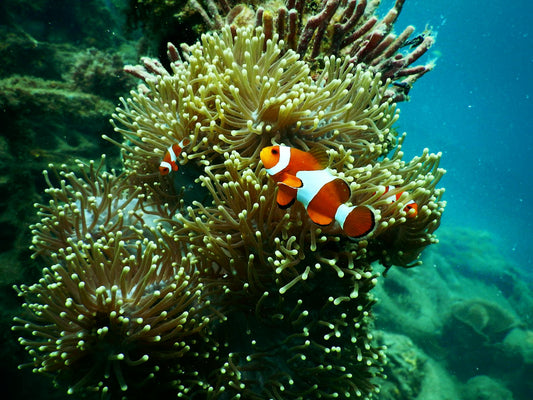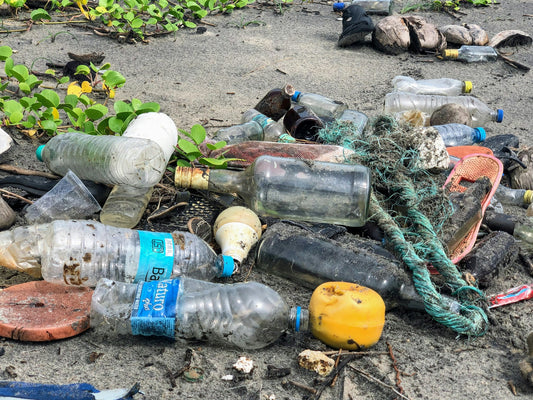Share
It's Just A Straw, Right?
It's a hot summer day. The sun is glistening as it reflects from the city skyline. You just got a delicious caramel frappuccino from the green coffee franchise and stroll through the city. The summer heat touches your skin.
You can feel the cold in your hands. Just as the sweat drops find their way down your forehead, the condensed water from your cup cools your hands. It runs down between your index finger and thumb, promising a delicious cooling.
You guide the cup to your mouth to take a deep frappalicious sip and ... WHATS THAT? A SOGGY PAPER STRAW?!...
Your day just got worse. How could they ruin your well deserved refreshment with that disgusting evil piece of paper? After all, that one straw doesn't make enough difference to destroy your frappuccino experience, right?
Well, let's find out!
In our new series "The Dirty Truth", we explore everyday items and the role they play in the big theme of pollution.
Today: Plastic Straws.
Plastic straws are some of the items first affected by plastic bans in many countries. In this article we'll explore, how much they really contribute to pollution.
For that, we'll start with some high level facts about plastic straws. Then we make our way to their production and usage, finishing with their disposal.
Plastic straws in numbers

How many plastic straws do we use?
It is hard to find an exact estimate about the average daily use of plastic straws. Many sources cite an estimated 500 million straws a day for the US alone.
That would be 182.5 billion a year and 350.000 per minute.
Some countries have started banning plastic straws. Still, it is estimated that plastic straws still make up about 99% of the $3 billion global drinking-straw market.
Once they've served their purpose, plastic straws take around 200 years to decompose. That means your great grand child will still be dealing with the waste from today's frappuccino.
Because of their little weight plastic straws only account for 0.2% of the yearly plastic waste in the US by weight. After all, a single straw only weighs about 0.42 grams or one sixth of an ounce.
In total that still adds up to 73,000 metric tons per year, which is about the weight of 540 Boeing 777. Just plastic straws!
Take Action Now! Order sustainable glass straws and replace plastic straws forever!
How Plastic Straw Production Pollutes the Environment
As they are so little and light, how much pollution can plastic straws really cause during their production?
Most plastic straws are manufactured from polypropylene (or sometimes polystyrene). That's a material mainly based on oil and derived through a process called polymerization.
Polypropylene, together with colorants and other chemical ingredients are then mixed together in a machine that looks like a big heated meat grinder. There, the mixture is melted into beads, which are later shaped into small strands.
The strands are then turned into pellets, which are then melted again and pushed into a long tube shape.
Finally, the tube is cooled down and cut into straw length.
Straws are then packaged and shipped.
Beads, strands, pellets, tube, done - You Got It!
This whole process costs around 1.44 KG CO2 per three straws or 0.48 KG per single straw.
That may not be much per straw. But if we add up that CO2 footprint with the number of straws produced in the US, the CO2 impact of plastic straw production equals the average emissions of 19 million cars driven for a year.
Additionally, plastic straws directly consume crude oil and natural gas for production.
1000 kg of polypropylene uses 75 kg oil and 61 kg natural gas, which puts the yearly consumption for plastic straws at 57.5 tons of oil and 46.7 tons of natural gas.
It does not stop with resource consumption and CO2 impact of plastic straw production. Plastic production in general is known for its bad environmental impact and leaking chemicals and microplastics into the environment.
While we won't go into detail for plastic straws, our previous article about plastic bottles dives a little deeper into the broader impact of plastic production.
As we've gotten an idea about the impact of plastic straws during production, let's look at the pollution and dangers of using them.
How Plastic Straw Usage Pollutes the Environment
As is the case with any plastic product that comes in contact with food or beverages, plastic straws can leach chemicals and microplastics.
Some straws are still manufactured from polystyrene. It is a plastic that can be hard or soft like foam, often called "Styrofoam™".
Polystyrene contains chemicals like benzene, butadiene, and styrene that can get into food and harm health. Styrene specifically can cause eye, nose, and throat irritation, affect the nervous system, and causes cancer.
Certain plastic straws and drinkware can let out harmful chemicals into drinks. Using plastic items repeatedly and cleaning them can create small cracks where chemicals can escape.
Efforts are being made in the U.S., Canada, and Europe to limit these chemicals in plastic food and drink items and to ban some single-use plastic products. Not all companies are following these rules, and the plastic and chemical industries are resisting change.
It's important to consider if the convenience of using so much plastic is worth the health risks.
We could not find any specific studies on the microplastics leaking from drinking straws. Nevertheless, it is never a good idea to expose our bodies to excessive amounts of plastic if we can avoid it.
Many studies have shown the worrying impact from microplastics. If they enter our metabolism they can affect the human body in many ways.
If you are wondering why that should be a huge "no-no" for using plastic straws, check out our article about microplastics in the human body and its effects.
It won't come as a surprise for you that plastic drinking straws enter the worst part of their lifecycle, when they are disposed.
How Plastic Straw Disposal Pollutes the Environment

Let's explore the impact of plastic straw disposal on pollution from two angles, managed plastic waste and mismanaged plastic waste.
Managed plastic waste is the waste that ends up in a bin and reaches a waste management facility.
Once you've sipped your frappuccino, you may be wondering which is the right bin for that little plastic straw.
While plastic straws can technically be recycled, they rarely are.
As we mentioned above, most straws are made from polypropylene, which is one of the least recycled plastics globally. Only around 3% of polypropylene products are recycled.
What makes plastic straw recycling even more difficult is the problem that they are very small, thin, and flexible.
This causes issues because they can get stuck in the recycling machines. So most facilities don't even take plastic straws in the first place.
Consequently, at least 97% of plastic straws that are properly disposed of end up on the landfill or are incinerated. This contributes to global warming or breaks up the straws into harmful microplastics.
Even worse that that are straws that find their way into the environment.
Again at first sight, plastic straws make up only 0.025% by weight of the 8 million tons of plastic that flow into the ocean every year. Their impact should not be underestimated though.
A study from 2017 estimates that 8.3 billion plastic straws pollute the world's beaches and they are on position 7 of the top 10 plastic items found in ocean cleanups.
Once the straws are in the marine environment, they pose a threat to wildlife.
What makes plastic straws especially dangerous for wildlife is their shape.
Straws can hurt, sicken, or even kill wildlife, when the straws get stuck in their noses, throats, or stomachs. Especially animals like seabirds, fish, sea turtles, manatees, and dolphins are affected.
Nothing shows the terrible impact of plastic straws better than a viral video showing how environmentalists remove a plastic straw from a turtle's nose.
Even if they are not directly causing harming wildlife, they cause microplastic pollution.
When plastic straws are left outside in the sun, waves, wind, and different temperatures, they start to break into really tiny pieces.
These tiny pieces are called microplastics. Microplastics can go into the bodies of all living things, including us humans.
We don't know all the ways microplastics affect us and the environment, but researchers believe that microplastics are making climate change worse and causing health problems in humans.
A Big Price For A Little Convenience
As you see, plastic straws cause a lot of trouble for the little convenience they bring.
Their production emits carbon dioxide equivalent to millions of cars. Their usage poses health risks through chemical leaching. Finally their disposal contributes to landfills, incineration, and ocean pollution.
Plastic straws have a significant negative impact and their small size doesn't diminish the harm they cause.
They contribute to the growing problem of plastic pollution hat affect both wildlife and human health. It is especially their small size that poses a threat to marine wildlife.
The convenience of a plastic straw comes at a high cost to our planet, emphasizing the importance of considering sustainable alternatives.
Eco-Friendly Alternative
It is time to rethink our habits and lessen the impact of such everyday items on our environment.
And if you like straws for your drink there are fantastic alternatives!
Like these Grass Straws, that never get soggy and are fully biodegradable.

There really isn't any reason to rely on plastic straws for the little convenience they bring.
Eiher try ditching straws together or at least try a sustainable alternative the next time you enjoy your frappuccino.
We hope you enjoyed this article. If you want to read more like this, make sure to check out our Blog and follow us on Instagram. If you are interested in truly sustainable products, check out our Shop.
Want to read the other two articles in our series "The Dirty Truth"? Here you go!
The Dirty Truth: How Much Plastic Bags Really Contribute to Pollution (2023)
The Dirty Truth: How Much Plastic Water Bottles Really Contribute to Pollution (2023)
If you want to engage in the discussion, feel free to leave a comment below.








